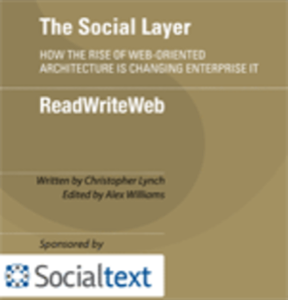I am writing a post about ten trends that point to long-term growth in the enterprise technology market.

I keep going back to the report we published last week. I am curious if the trends I am highlighting track with what Christopher Lynch wrote in his report: The Social Layer: How the Rise of Web-Oriented Architecture is Changing Enterprise IT
It looks like they do. You can point to almost any trend in the enterprise and see the relationship to Web oriented architecture and open standards.
Here is the report and three examples of what is shaping enterprise IT.
The Social LayerView more documents from ReadWriteWeb.

The rise of scripting languages, open frameworks and the “view source” culture
The enterprise is just realizing that the knowledge they have held so dearly over the years has meaning. But its outside the network where the real power resides. It’s the greater community that holds the knowledge. Dion Hinchcliffe made the point recently when discussing the rise of social business:
“In this new world success is defined by how well you can connect with and tap into the global network, both for obtaining value and delivering it. And to be perfectly clear, I am not saying that all value is going come from outside of enterprises in the future, far from it. But in general, organizations are now greatly outnumbered by the resources on the network and real business value is increasingly coming from the social world as we learn how to participate in it.”
As Chris points out in the report, companies are adopting more lightweight scripting languages:
“Suddenly, in the enterprise, the technologies powering the open Web reminded us that the complexity of software development and architectural frameworks that facilitate the integration of disparate applications need not be so high. The stack-based development models built on Java and .Net languages — which remained a staple in the enterprise architecture — put unnecessary requirements on how you could integrate applications, unlike the ease of open Web architectures and dynamic programming languages that allowed you to point data at anything with “HTTP” in the address. This phenomenon explains why you can see such diverse content from all around the Web seamlessly integrated into Facebook and Twitter homepages.”
REST and the Enterprise
We were talking the other day with one of the world’s largest technology companies. We asked about one of their services. “Oh, of course, it’s REST based.” We hear that more often. REST is the way the enterprise is broadly integrating Web-oriented applications. It’s how platforms are extending. It’s the glue for cloud services. We could go on and on. Here’s the insight Chris provided:
“The prevalence of REST in the development world has naturally been felt in the enterprise, especially as IT departments juggle a variety of applications and databases that have accumulated across their company over the course of multiple years. As enterprise architectures become more decentralized to meet the long list of vendors serving the enterprise world, most developers view SOAP as too complex — or at least too complex as it relates to the effort involved in writing connectors.”
Building the Social Layer in the Enterprise Architecture
On of the more interesting trends for us to watch is how social technologies surface information. Activity streams are monitoring applications to notify people about updates. This is part of a longer trend that we have seen with the social Web. RSS helped us monitor updates to blogs. It has since become a research technology and a way to dynamically update web sites. The new social layer takes many of these principles and applies them to the enterprise:
“With the ability to filter by tags, groups and transaction types, companies know their employees are getting the most relevant information. Because these events and updates surface in a microblogging or activity stream, employees can view, discuss, and take action on critical information, events and processes. The result: Companies can transform core business processes that had previously been walled off by information silos across their company. By injecting activity streams with diverse updates, content and events spanning the entire company and all its systems, employees can collaborate across the enterprise to solve business challenges and tackle new opportunities.”
These are just a few examples of how enterprise trends fit with the advent of a Web Oriented architecture.
We’ll explore more examples in our post about trends that point to a growing enterprise technology market.





















